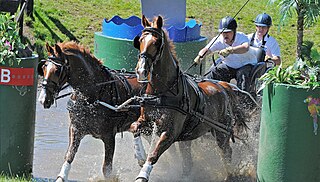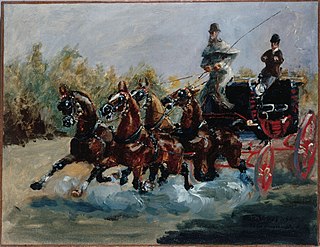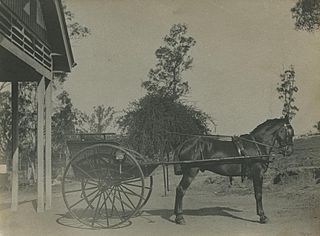
A cart or dray is a vehicle designed for transport, using two wheels and normally pulled by draught animals such as horses, donkeys, mules and oxen, or even smaller animals such as goats or large dogs.

A carriage is a private four-wheeled vehicle for people and is most commonly horse-drawn. Second-hand private carriages were common public transport, the equivalent of modern cars used as taxis. Carriage suspensions are by leather strapping or, on those made in recent centuries, steel springs. Two-wheeled carriages are informal and usually owner-driven.

The hansom cab is a kind of horse-drawn carriage designed and patented in 1834 by Joseph Hansom, an architect from York. The vehicle was developed and tested by Hansom in Hinckley, Leicestershire, England. Originally called the Hansom safety cab, it was designed to combine speed with safety, with a low centre of gravity for safe cornering. Hansom's original design was modified by John Chapman and several others to improve its practicability, but retained Hansom's name.

A horse and buggy or horse and carriage refers to a light, simple, two-person carriage of the late 18th, 19th and early 20th centuries, drawn usually by one or sometimes by two horses. Also called a roadster or a trap, it was made with two wheels in England and the United States. It had a folding or falling top.

A sulky is a lightweight cart used for harness racing. It has two wheels and a small seat for only a single driver. The modern racing sulky has shafts that extend in a continuous bow behind the driver's seat, with wire-spoked "bike" wheels and inflated tyres. A sulky is frequently called a "bike". Historically, sulkies were built for trotting matches and made from wood with very tall wheels and almost no body, just a simple frame supporting a single seat. Such vehicles were called "sulkies" because they were "said to have been chosen by unsociable people fond of their own company or fits of sulking".

Combined driving is an equestrian sport involving carriage driving. In this discipline, the driver sits on a vehicle drawn by a single horse, a pair or a team of four. The sport has three phases: dressage, cross-country marathon and obstacle cone driving — patterned after the mounted equestrian sport of eventing. It is one of the ten international equestrian sport horse disciplines recognized by the Fédération Équestre Internationale (FEI). Combined driving became an FEI discipline in 1970 when Prince Philip, Duke of Edinburgh, the then-president of FEI, produced the first rule book.

A horse-drawn vehicle is a piece of equipment pulled by one or more horses. These vehicles typically have two or four wheels and were used to carry passengers or a load. They were once common worldwide, but they have mostly been replaced by automobiles and other forms of self-propelled transport but are still in use today.

Carriage driving is a form of competitive horse driving in harness in which larger two- or four-wheeled carriages are pulled by a single horse, a pair, tandem or a four-in-hand team. Prince Philip, Duke of Edinburgh helped to expand the sport. He started to compete in carriage driving in 1971, and the early rule book was drafted under his supervision.

A marathon carriage is a modern metal carriage that is used for driving competitions, especially combined driving. It is named after the cross-country phase of a combined driving event which, though inaccurate, became known as the "marathon" phase. The carriage is designed for safety and carries a driver plus one or two assistants, called grooms. Drivers direct the horses while grooms counterbalance the carriage on tight turns, and are available for assistance with the horses in case of an overturn or collision, or equipment malfunction.

Driving, when applied to horses, ponies, mules, or donkeys, is a broad term for hitching equines to a wagon, carriage, cart, sleigh, or other horse-drawn vehicle by means of a harness and working them in this way. It encompasses a wide range of activities from pleasure driving, to harness racing, to farm work, horse shows, and even international combined driving.

A horse harness is a device that connects a horse to a horse-drawn vehicle or another type of load to pull. There are two main designs of horse harness: (1) the breast collar or breaststrap, and (2) the full collar or collar-and-hames.

A coach is a large, closed, four-wheeled, passenger-carrying vehicle or carriage usually drawn by two or more horses controlled by a coachman, a postilion, or both. A coach has doors in its sides and a front and a back seat inside. The driver has a raised seat in front of the carriage to allow better vision. It is often called a box, box seat, or coach box. There are many of types of coaches depending on the vehicle's purpose.

A trap, pony trap or horse trap is a light, often sporty, two-wheeled or sometimes four-wheeled horse- or pony-drawn carriage, usually accommodating two to four persons in various seating arrangements, such as face-to-face or back-to-back. In the eighteenth century, the first carriage to be called a trap was a gig with a hinged trap door, under which was a place to carry a dog. In late nineteenth century USA, four-wheeled dog carts with convertible seats also started to become known as traps.

Volante is a two-wheeled open carriage with a retractable hood that was popular in Cuba in the mid-1800s. The vehicle was directed by a postilion rider. The large wheels are positioned behind the seat and are over 6 feet in diameter with an 8.5 inch hub. Most of the volantes were imported to Cuba from England, France, or the United States.

Breeching ( "britching") is a strap around the haunches of a draft, pack or riding animal. Both under saddle and in harness, breeching engages when an animal slows down or travels downhill and is used to brake or stabilize a load.

A runabout is an American light, open, horse-drawn vehicle with four large wheels that predated the runabout car.

The Remington Carriage Museum is located in Cardston, Alberta, Canada. Opened in 1993, and the largest of its kind in the world, the Remington Carriage Museum displays more than 240 carriages.

The Horseshoe Barn and Horseshoe Barn Annex are two exhibit buildings located at Shelburne Museum in Shelburne, Vermont. Both buildings exhibit a variety of horse-drawn vehicles, including carriages, trade wagons, stagecoaches, and sleighs.

The Imperial Carriage Museum is a museum of carriages and vehicles used by the imperial household of the Holy Roman Empire, the Austrian Empire and Austria-Hungary. It is housed in the grounds of the Schloss Schönbrunn in the Hietzing district of Vienna and is a department of the Kunsthistorisches Museum.

The Long Island Museum of American Art, History, and Carriages, known as the Long Island Museum (LIM), is a nine-acre museum located in Stony Brook, New York. The LIM serves the Long Island community by preserving and displaying its collection of art, historical artifacts, and carriages; providing educational and public programming; and collaborating with a variety of other arts and cultural organizations.






















